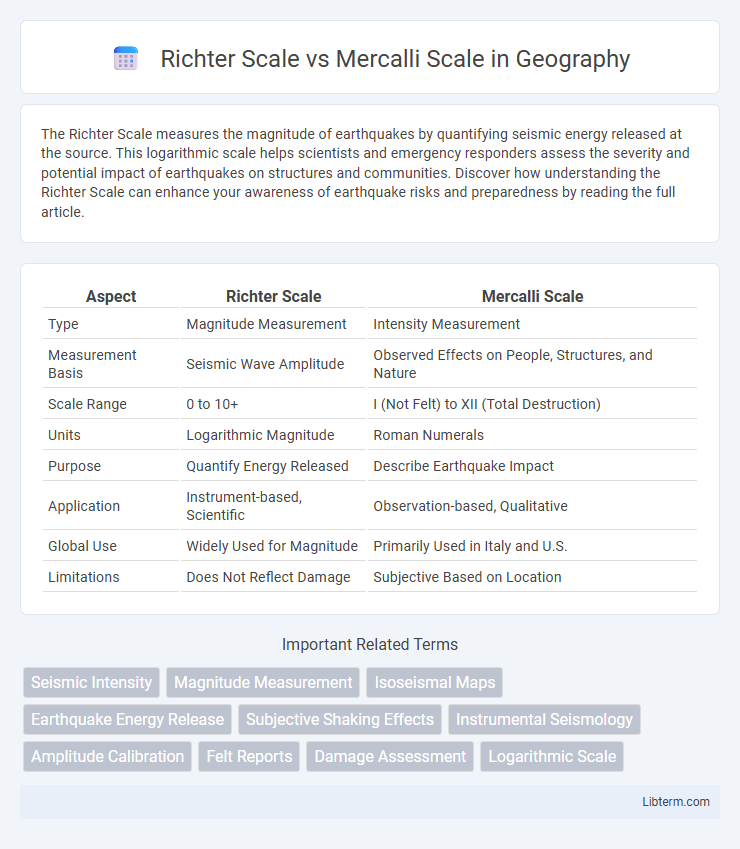The Richter Scale measures the magnitude of earthquakes by quantifying seismic energy released at the source. This logarithmic scale helps scientists and emergency responders assess the severity and potential impact of earthquakes on structures and communities. Discover how understanding the Richter Scale can enhance your awareness of earthquake risks and preparedness by reading the full article.
Table of Comparison
| Aspect | Richter Scale | Mercalli Scale |
|---|---|---|
| Type | Magnitude Measurement | Intensity Measurement |
| Measurement Basis | Seismic Wave Amplitude | Observed Effects on People, Structures, and Nature |
| Scale Range | 0 to 10+ | I (Not Felt) to XII (Total Destruction) |
| Units | Logarithmic Magnitude | Roman Numerals |
| Purpose | Quantify Energy Released | Describe Earthquake Impact |
| Application | Instrument-based, Scientific | Observation-based, Qualitative |
| Global Use | Widely Used for Magnitude | Primarily Used in Italy and U.S. |
| Limitations | Does Not Reflect Damage | Subjective Based on Location |
Introduction to Earthquake Measurement Scales
The Richter Scale quantifies earthquake magnitude by measuring the amplitude of seismic waves recorded by seismographs, providing a numerical value for energy released. The Mercalli Scale assesses earthquake intensity based on observed effects and damage, offering a qualitative measure of impact on structures and people. Together, these scales complement each other by delivering both objective energy data and subjective damage reports for comprehensive earthquake analysis.
What is the Richter Scale?
The Richter Scale measures the magnitude of an earthquake by quantifying the seismic energy released, using logarithmic calculations based on amplitude recorded by seismographs. Developed in 1935 by Charles F. Richter, it provides numerical values to depict earthquake strength, ranging from minor tremors to massive quakes. Unlike the Mercalli Scale, which assesses earthquake intensity based on observed effects and damage, the Richter Scale offers an objective, standardized magnitude measurement.
Understanding the Mercalli Scale
The Mercalli Scale measures earthquake intensity based on observed effects and damage rather than energy release, providing a qualitative assessment through 12 increasing levels of intensity. Unlike the Richter Scale, which quantifies magnitude using seismic wave amplitude, the Mercalli Scale captures human and structural impact, making it valuable for assessing earthquake damage in specific locations. Its subjective nature depends on eyewitness reports and structural vulnerabilities, offering a practical perspective on earthquake severity.
Key Differences Between Richter and Mercalli Scales
The Richter Scale measures the magnitude of an earthquake by quantifying the seismic energy released using a logarithmic scale, providing a precise numerical value. The Mercalli Scale, in contrast, assesses the intensity of an earthquake based on observed effects and damage, offering a subjective evaluation expressed through Roman numerals from I to XII. While Richter estimates the earthquake's size regardless of location, Mercalli reflects the impact on people, buildings, and the Earth's surface at specific sites.
How the Richter Scale Measures Earthquake Magnitude
The Richter Scale quantifies earthquake magnitude by measuring the amplitude of seismic waves recorded on a seismograph, providing a logarithmic scale where each whole number increase represents a tenfold increase in wave amplitude and roughly 31.6 times more energy release. Developed in 1935, it calculates magnitude based on the maximum wave amplitude corrected for distance from the earthquake epicenter. Unlike the Mercalli Scale, which assesses earthquake intensity through observed effects and damage, the Richter Scale delivers a precise, numerical measurement of an earthquake's energy release.
How the Mercalli Scale Assesses Earthquake Intensity
The Mercalli Scale assesses earthquake intensity by evaluating observed effects and damage to structures, landscapes, and people's experiences, ranging from I (not felt) to XII (total destruction). Unlike the Richter Scale, which measures seismic energy released through instrument readings, the Mercalli Scale provides a qualitative assessment based on eyewitness reports and physical evidence. This intensity-based approach allows for mapping the varying impact of an earthquake across different locations.
Applications of the Richter and Mercalli Scales
The Richter Scale is primarily used to quantify the magnitude of an earthquake by measuring seismic wave amplitude, making it essential for scientific analysis and early warning systems. The Mercalli Scale evaluates the intensity and effects of an earthquake based on observed damage and human perception, aiding emergency response and structural assessments. Together, these scales provide complementary data crucial for earthquake preparedness, engineering safety standards, and disaster management planning.
Advantages and Limitations of Each Scale
The Richter Scale quantifies earthquake magnitude based on seismic wave amplitude, providing an objective, standardized measurement ideal for comparing earthquake energy release globally, but it may underestimate large, distant quakes and lacks detailed damage assessment. The Mercalli Scale evaluates earthquake intensity using observed effects and structural damage, offering a localized impact perspective valuable for emergency response and urban planning, yet it is subjective, varies by observer judgment, and cannot measure earthquake energy directly. Combining Richter's precise magnitude data with Mercalli's detailed intensity reports enhances comprehensive seismic analysis and risk mitigation strategies.
Real-World Examples: Comparing Scale Outcomes
The Richter Scale measures earthquake magnitude by quantifying seismic energy release, exemplified by the 1989 Loma Prieta earthquake, recorded at 6.9 magnitude. The Mercalli Scale assesses earthquake intensity based on observed effects; during the same event, it reached a maximum intensity of IX (Violent), causing significant structural damage and ground shaking in affected areas. Comparing these scales highlights how Richter values provide objective magnitude data, while Mercalli readings capture human and structural impact, offering complementary insights for seismic assessment.
Conclusion: Choosing the Right Scale for Earthquake Analysis
The Richter Scale quantifies earthquake magnitude by measuring seismic energy release, providing precise numerical values essential for scientific analysis and comparison. The Mercalli Scale assesses earthquake intensity based on observed effects and damage, offering valuable insight into human and structural impact in specific locations. Selecting the appropriate scale depends on the need for either objective magnitude measurement or subjective intensity evaluation to inform emergency response and risk assessment.
Richter Scale Infographic

 libterm.com
libterm.com